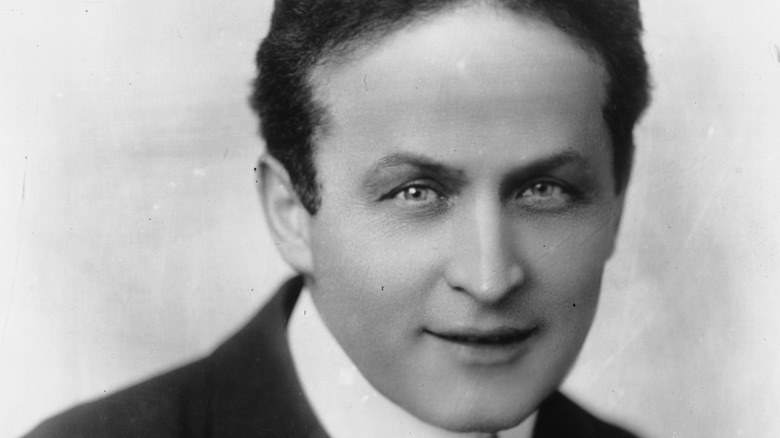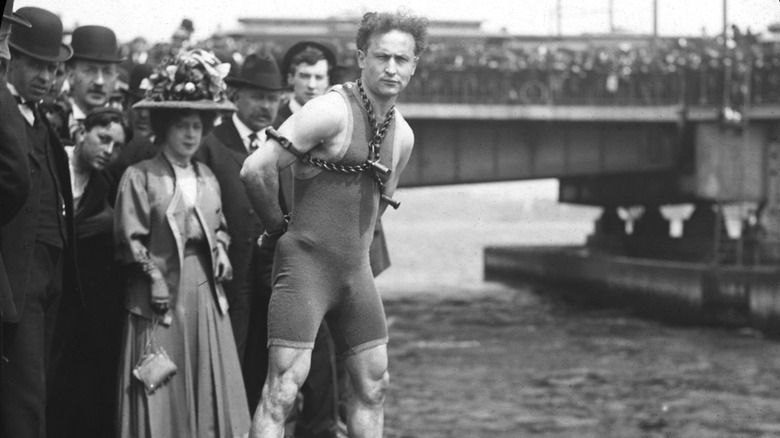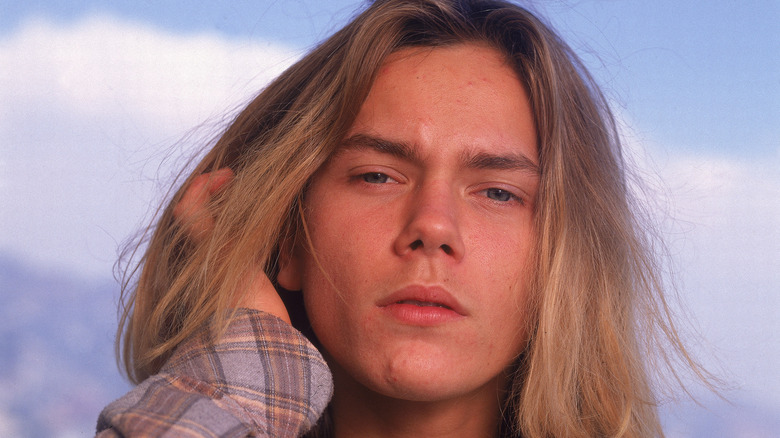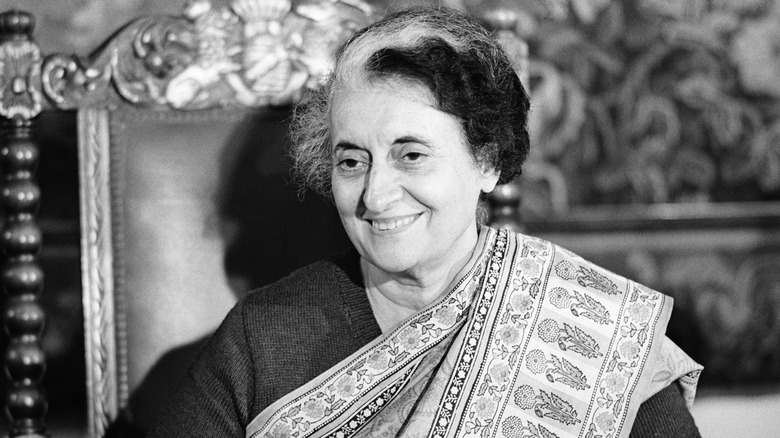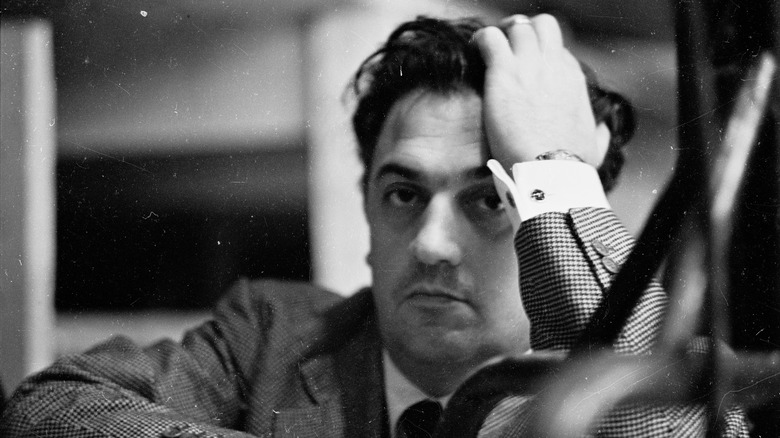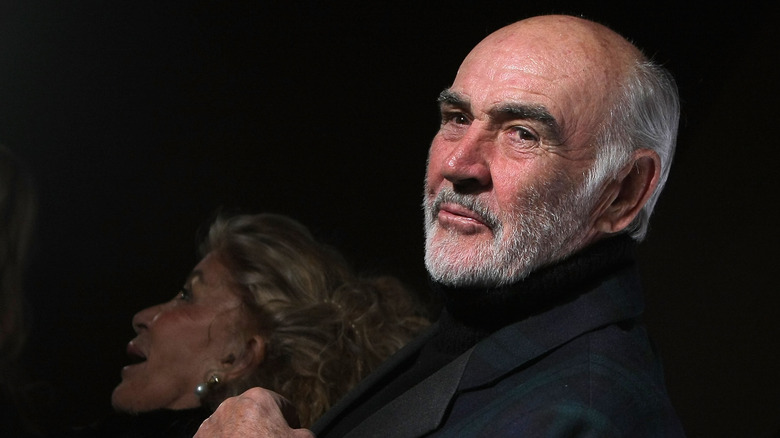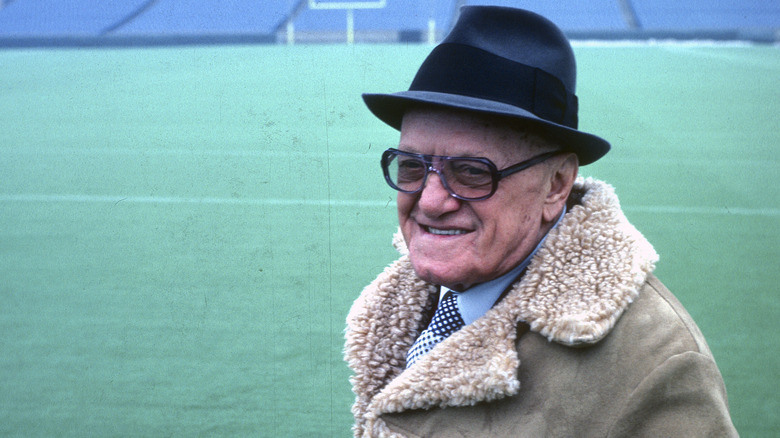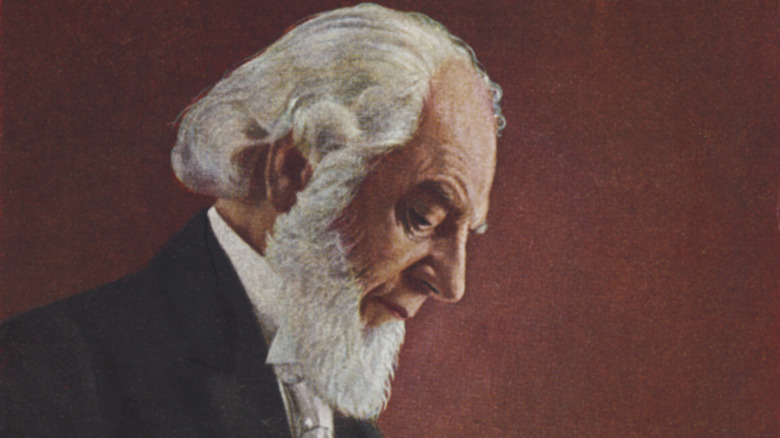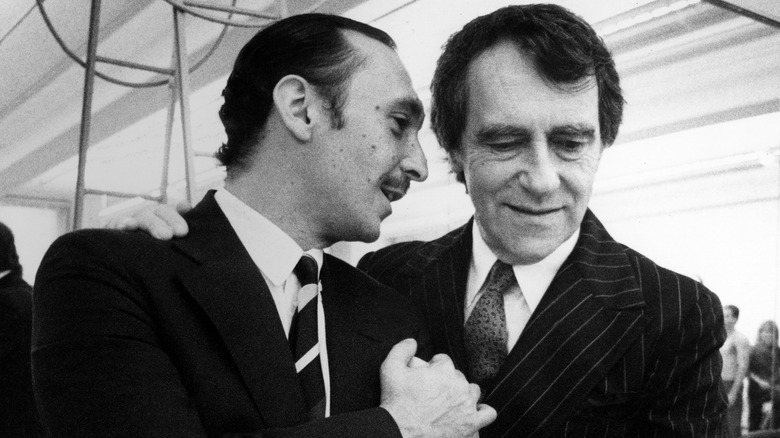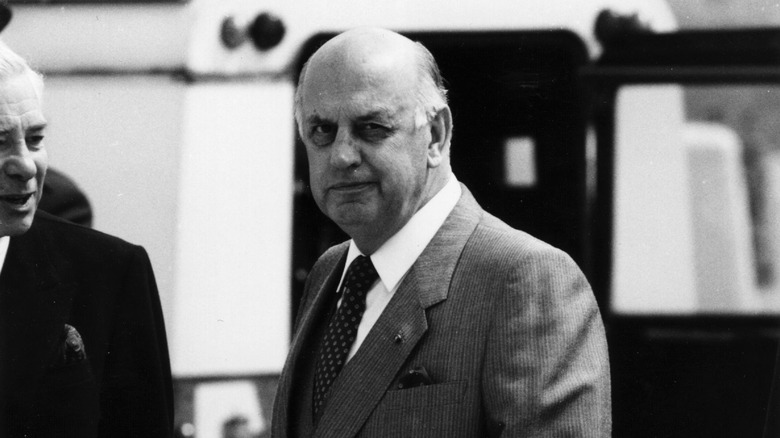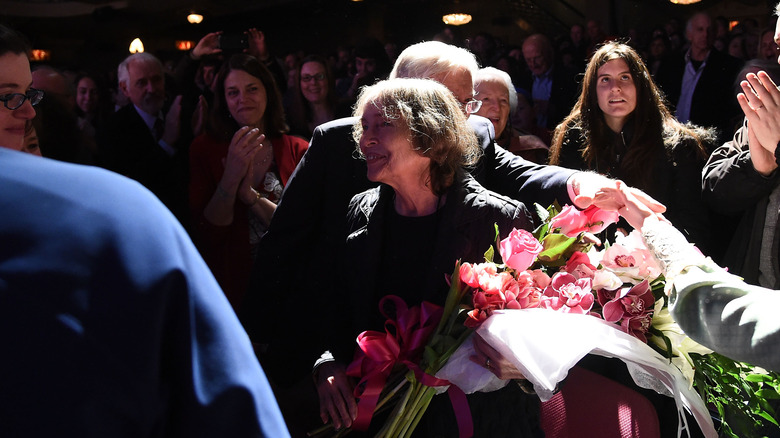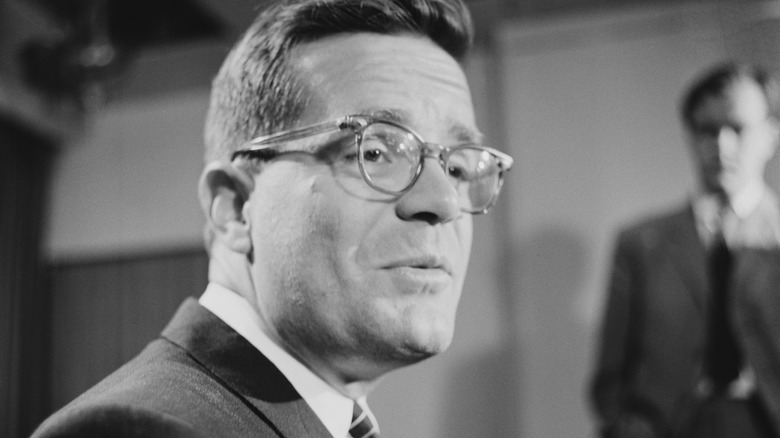Famous People Who Died On Halloween
'Tis the season to talk about and celebrate ghosts, and what's more apropos than looking at those who crossed over on Halloween itself? Halloween is rooted in the ancient beliefs of Celtics who celebrated the harvest festival of Samhain by lighting bonfires and wearing costumes, according to History. They believed that ghosts roamed the earth on October 31, and the costumes would protect them from these spirits. So, it's not so surprising that Harry Houdini passed away on this ominous day since he spent much of his time criticizing supernatural beliefs and those who said they could communicate with the dead, per History. The other names on this list are not so easily explained, unless it's all just a coincidence.
Below is a list of some of the more recognizable names, but here are some honorary mentions. There's George Washington De Long who, in 1881, led an ill-fated Arctic expedition from the coast of Siberia, notes Britannica. His trip, although ending tragically, gave credence to the idea of a trans-Arctic drift. There was István, Count Tisza, the prime minister of Hungary from 1903 to 1905 and 1913 to 1917. He was assassinated on Halloween 1918 after people blamed him for the country's poor state during World War I, per Britannica. Then there is Brian Cobby, the British voice actor, who voiced the British Telecom's speaking clock for more than 20 years, reports The Guardian. Read on for more.
Harry Houdini
It seems fitting that legendary escape artist and magician Harry Houdini would have died on as whimsical of a date as October 31. And the manner of his death carries the same mystique as his life. It all began after one of his shows at the Princess Theatre in Montreal on October 22, explains PBS. A student at the nearby McGill University came into Houdini's dressing room to see if the illusionist really had the abs of steel that came as part of his reputation. The student, J. Gordon Whitehead, proceeded to punch him in the stomach. He hadn't been the first fan to do so. But something about this incident was different from others; Houdini likely wasn't ready and hadn't properly prepared himself. The punches put Houdini into a state of agony, and he suffered from stomach pains afterwards. He died eight days later from appendicitis-caused peritonitis.
Several theories have circulated on his cause of death. Some believe that Whitehead's punches caused the ruptured appendix. It's also possible there was no correlation, but the punches still led to Houdini's death because he dismissed his stomach pains as nothing more than soreness. Houdini had also made enemies as a vocal anti-Spiritualist — the movement that claimed the living can communicate with the dead — and some believe that he could've been poisoned, per History. Whatever it may be, his Halloween death launched a tradition in which fans hold yearly séances to try to reach him in the afterlife.
River Phoenix
River Phoenix's tragic death has become part of Hollywood legend, considering that he spent his last night out at the iconic West Hollywood nightclub Viper Room, reports the New York Times. And he collapsed right outside its entrance before he was rushed to the hospital. He was an actor and singer who was known for his roles in "Stand by Me" and "Running on Empty." Phoenix was only 23 years old and was destined to have a remarkable career; he was slated to star in the 1994 film adaptation of "Interview With the Vampire" and already had an Oscar nomination, per New York Times. His role ended up going to Christian Slater, per Nola. Maybe he would've had a career comparable to his younger brother, Joaquin, who was on hand that tragic night to call an ambulance, the New York Times reports. His frantic phone call was released to media outlets and went viral.
River's autopsy revealed he'd ingested a fatal concoction of cocaine and morphine, along with a few other drugs. It was a surprise to those who knew him — he had a reputation for clean eating and vegetarianism. After his death, the Viper Room, which was partly owned by Johnny Depp, closed down temporarily, per the New York Times.
Indira Gandhi
When Indira Gandhi became prime minister of India in 1966, she was the first female in the country's history to do so, per Biography. But it wasn't all sunshine and rainbows; Gandhi developed an authoritarian reputation after jailing her opponents and was once imprisoned herself, Biography explains. She was also prime minister at a time of separatist conflict and deep unease. The Sikhs that populated the state of Punjab were largely unhappy with the status quo and wanted autonomous statehood, notes Britannica. She tried to appease the community by granting them the city of Chandigarh as their capital but that measure failed, and Sikh extremists soon took control of their holiest site, the Harmandir Sahib, by force. The separatists saw this action as necessary in order to establish Sikh Khalistan, their desired independent state. But the militant Sikhs presented far greater problems than gaining control of their holy site; they enacted violence against anyone who got in the way of their goals for statehood. They killed Hindus living in Punjab and moderate Sikhs (per Britannica) while violence and terror attacks spread to Haryana and Delhi.
Gandhi brought down the hammer and greenlit Operation Bluestar. Indian troops fired down the temple and killed one of the Sikh separatist's leaders, Jarnail Singh Bhindranwale, along with their gunmen, per Britannica. But the operation wreaked general havoc, and many innocent people died. In the aftermath, Gandhi was assassinated by two of her Sikh bodyguards on October 31, 1984.
Federico Fellini
If you don't know who Federico Fellini is, you only have to look at the legendary directors who have cited his work as inspiration: Stanley Kubrick (per Michel Ciment's "Kubrick"), Spike Lee (per Time), Guillermo del Toro (per NPR), Woody Allen, Tim Burton, and Terry Gilliam, among many others, per BFI. Martin Scorcese wrote a whole article in Harper's Magazine to extol his talent and proclaim that most today will never live up to Fellini's artistry. Some of his oft-cited work include "8 1/2," "La Dolce Vita," "Roma," and "La Strada," NPR notes. Felllini was and remains a little controversial for his maximalist style and fearless portrayal of crude subjects like prostitution, but his movies, particularly "8 1/2," is often charted in the top 10 best movies of all time.
He was born in Italy and although he's known to many in the West as a "foreign filmmaker," it didn't stop him from becoming nearly a household name — at least to those who cared about groundbreaking films. He retired with five Academy Awards, one being an honorary Oscar, according to the New York Times. He died in 1993 at 73 years old.
Sean Connery
Sean Connery made his mark in the entertainment industry by his portrayal of James Bond in seven different "007" movies — and he was the first actor to play the spy. He was born Thomas Sean Connery in Fountainbridge, Scotland, per Biography, and his family was so poor that he had to sleep inside a drawer as a baby. But he was endowed with good looks, and before he graced the silver screen, he was once awarded a medal in the Mr. Universe pageant. His charm carried him to Hollywood where he made several films before his breakout role in "Dr. No." Eventually, Connery's legend grew so large that he could do without James Bond and made 1971's "Diamonds are Forever" his last; that is, until he returned for 1983's "Never Say Never Again." The title of that Bond film was in reference to Connery formerly saying he would never return, according to History.
He went on to round out his career with roles in Alfred Hitchcock's "Marnie," Sidney Lumet's "Murder on the Orient Express," and his Academy Award-winning performance in "The Untouchables," among various more, per The New York Times. Connery died in his sleep on Halloween 2020. His family honored his dying wish that his ashes be scattered in his homeland of Scotland, reports People.
Greg Moore
Greg Moore started fast and strong when he first came into the motor racing scene. In his first win for the Championship Auto Racing Teams (CART), he was the youngest driver ever at the time to accomplish the feat, per NBC Sports. He went on to win four more times in his four-year career with CART. And prior to his last race, he won 2nd place in the 1998 Marlboro 500, per Motorsport. It wouldn't be hard to imagine that Moore would go onto establish a Hall of Fame career had he been given a chance. But he couldn't. On October 31, 1999, Moore drove his last race at that year's Marlboro 500 at California Speedway. Less than a quarter of the way into the race, Moore lost control of his car during a turn and crashed into the retaining wall. His car promptly disintegrated. He was airlifted to a nearby hospital, but he was pronounced dead a mere hour after the crash.
Nevertheless, Moore's short career still made an impact on Vancouver and Canada sports fans at large. More than 20 years later, the tragic crash remains on the minds of many fans in Vancouver, per The Province.
George Halas
The Lombardi Trophy could easily have been named after George Halas, but for now, the NFC Championship trophy is. And it isn't hard to see why. Halas had a triple-threat role with the Chicago Bears team he founded: He was the team's owner, served as its head coach, and once played as a defensive end. At the same time, per Britannica. It was the early days of the NFL, and Halas had been at Canton to take part in the league's founding, reports the New York Times. His colleagues included the luminary Jim Thorpe, and he once said he was replaced by Babe Ruth while he played for the New York Yankees — a little forgotten fact. As coach, he was a trailblazer and popularized the T-formation as the leading offensive scheme. During his tenure, the Bears won seven league championships (per Britannica) and accumulated a record-making 321 regular season wins. While Halas was active, he was likely the best coach in the NFL, per the New York Times.
But for all that he did for his own team, Halas should also be remembered for what he did for the NFL and all of football. For example, in 1956, he spoke passionately to Green Bay voters to keep the Packers in town, despite the fact that they were division rivals, ESPN explains. He retired in 1968 at the ripe-old coaching age of 73 and died in 1983 at 88, per the New York Times.
Charles Taze Russell
In 1872, Charles Taze Russell was a preacher and author who founded the International Bible Students Association, which later led to the formation of Jehovah's Witnesses, as detailed by Britannica. He started off as an Adventist but then began incorporating other non-traditional ideas, such as the idea that there's no eternal hell. His ideas, which included end-of-times predictions, gained traction, per Britannica. His new religious movement was also popularized by his famous biblical periodical "The Watch Tower," along with other books brought about by his publishing empire. At its height, his company, the Watch Tower Bible and Tract Society, had a circulation of 16 million books.
Russell's death on October 31 came amid a bladder infection, reports Phoenix New Times. But according to William Zellner and William Kephart's "Extraordinary Groups," Russell suffered heart failure. And although there's not much that's creepy or arcane about a popular Christian preacher to make a Halloween connection, the Jehovah's Witnesses Brooklyn Heights neighborhood that Russell helped establish had a network of underground tunnels connecting their main buildings. And considering that it was recently abandoned, it's been described as creepy, via Gothamist.
Joseph Papp
Joseph Papp might not have a name like Patti LuPone or Ben Vereen, but he's probably done more for Broadway and theater than most people. He founded the New York Shakespeare Festival and the Public Theatre (The debut of the longest-running show in Broadway history, "A Chorus Line," happened there), providing theater for low-income New Yorkers who wouldn't otherwise have access, according to PBS. His productions have won 28 Tony awards, and three Pulitzer Prizes. He also diversified the stage, giving opportunities to Hispanic and Asian-American creators and casting African-American actors in roles that called for none, notes PBS. He also had a run-in with controversial politics after being outed as a communist, but he pled the fifth in front of Congress. He also went head-to-head with New York politician Robert Moses, who wanted to end his Shakespeare-in-the-Park performances, but Papp won that battle.
His roots in theater originated in the unlikeliest of places: war. Jewish and no stranger to antisemitism, Papp was eager to fight in the Navy during World War II. There, he began staging shows for his fellow Navy men, one of whom was Bob Fosse. When he died in 1991 at 70 years old, all Broadway theaters dimmed their lights in his honor, reports the New York Times.
P.W. Botha
Pieter Willem Botha was a South African leader who was part of the last vestiges of the apartheid era. He defended apartheid even when it was becoming unpopular at home and abroad, according to the New York Times. A right-wing firebrand, Botha aligned himself with the Ox Wagon Fire Guard, a Nazi-allied paramilitary group, during World War II, but he later disavowed them. He was a member of Parliament around when the National Party enacted segregation and anti-intermarriage laws. He also became South Africa's defense minister while the globe ostracized the country for its racial policies, and he ordered military campaigns against the African National Congress. He continued to be a staunch defender of apartheid when he became prime minister in 1978, but by the 1980s, his iron hold on the country's zeitgeist began slipping.
Although he resisted the changing of tides, he undoubtedly sensed the inevitable evolution of race relations and eased on limitations placed on the Black population. His government rode back limitations on interracial marriages and other laws that had plagued the Black majority. His small concessions frustrated opinions on the right, and yet they were not strong enough to satisfy anti-apartheid forces, notes Britannica. Ever unpopular, he was forced to resign in 1989. Even after he was sentenced to prison after apartheid was abolished, Botha remained unapologetic about his policies, per the New York Times. He died in 2007 at 90 years old.
Natalie Babbitt
It appears as if Natalie Babbitt never found the Tucks' Fountain of Youth, as she died on Halloween in 2016, according to the New York Times. But her legacy as an author will likely last for ages; her 1975 magnum opus, "Tuck Everlasting," sold 4 million copies and has been translated into 27 languages. It was also made into two films and a Broadway play.
This was despite the fact that her entry into writing was accidental; she only took a writing course as a favor to her literary-aspiring husband. Her foray into publishing began as an illustrator, and when her husband no longer wanted to write, she wrote herself, per Publisher's Weekly. But it turned out to be a good decision — she won the first ever E.B. White Award for children's literature, an honor from the American Academy of Arts and Letters, the New York Times notes. She's also written an estimated 20 books.
Luckily for Babbitt, she didn't want to live forever, anyway. She said a life of immortality would be boring.
Theodore Sorensen
Theodore C. Sorensen didn't want to be known only as President John F. Kennedy's speechwriter, but his accomplishments in that area alone would make his career memorable. He worked with Kennedy to write some of his most iconic speeches, including his 1961 inaugural address and his speech on NASA's mission to the moon, according to The Guardian. But he was also the president's advisor and was valued by Kennedy for his intellectual prowess. In fact, Sorensen perhaps single-handedly, along with Robert Kennedy, saved the United States and maybe even the planet from a nuclear disaster. While the United States was on the brink of war thanks to the Cuban Missile Crisis, Sorensen was tasked with writing a carefully-written letter to Nikita Khrushchev in order to convince the Soviet leader to ease his position. Obviously, Sorensen was successful.
But Sorensen found his career cut short when Kennedy was assassinated per the New York Times. He tried to run for political office himself, but it went nowhere. He also lost the chance at a CIA director position. However, he found some comfort watching Senator Barack Obama's rise to presidency, reminding of his own journey with Kennedy. Sorensen died in 2010.
